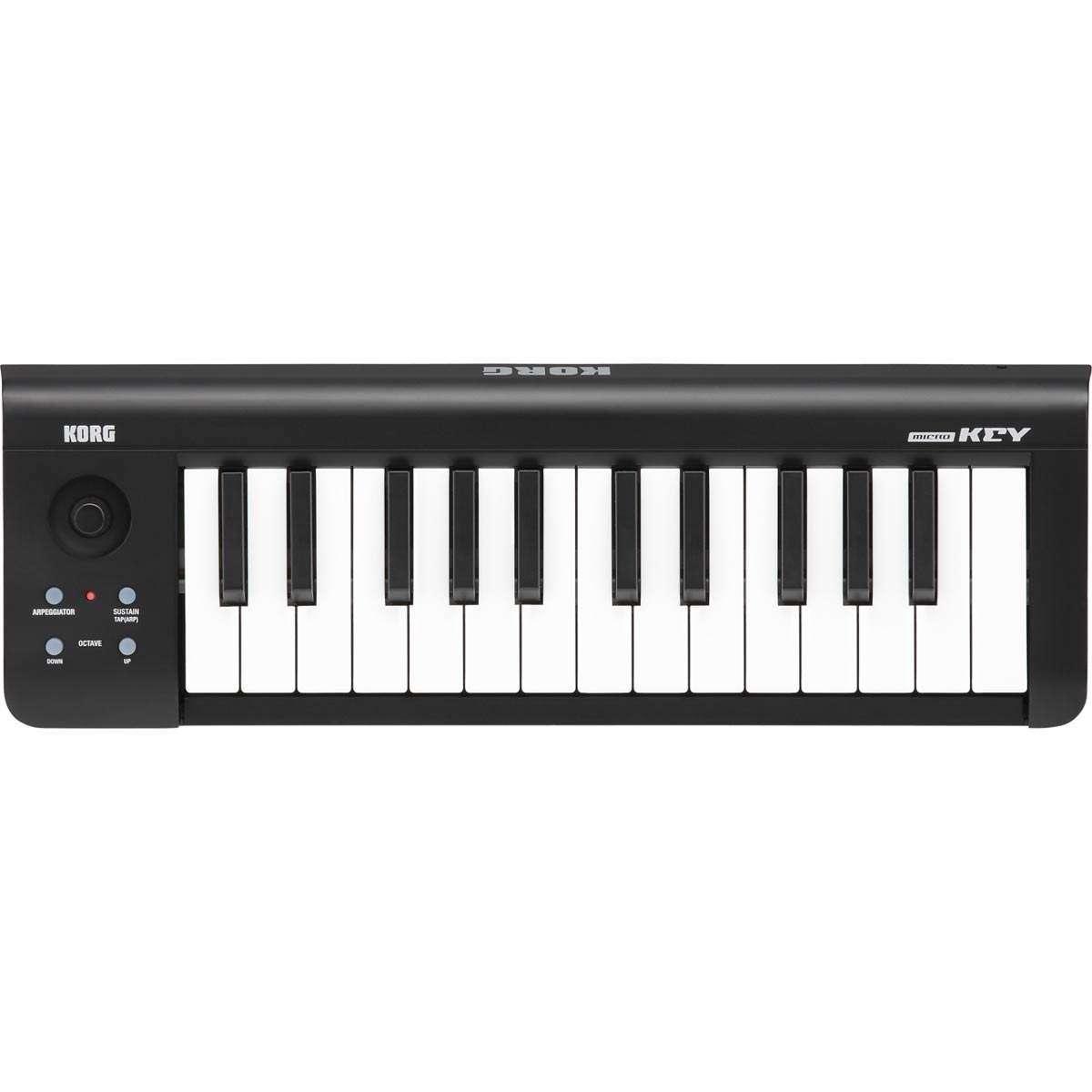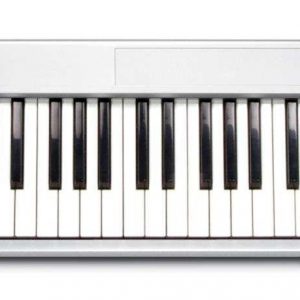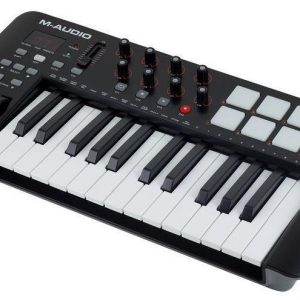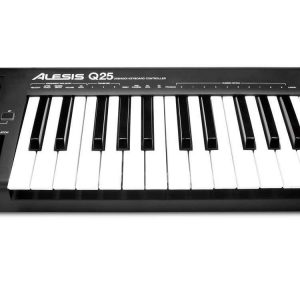Korg microKey 25
$37.99
Unleash your creativity and take your music production to the next level with Korg microKey 25 midi keyboard, designed to provide exceptional portability, versatility, and control.
Compare
Description
The Korg microKey 25 MIDI device is a powerful and portable keyboard controller that opens up a whole world of creative possibilities for musicians, producers, and hobbyists alike. This compact controller packs a wide range of features into a small package, making it the perfect choice for those who want to start making music on their computer or mobile device.
One of the standout features of the microKey 25 is its compact size. Measuring just over a foot in length and weighing only a few pounds, it can easily fit into a backpack or tote bag and be taken on the go. This makes it the perfect choice for musicians who want to be able to produce music wherever they go, whether they’re on a train, in a coffee shop, or simply in their bedroom.
Despite its small size, the microKey 25 is packed with features that make it a powerful and versatile MIDI controller. It features 25 velocity-sensitive keys, allowing for accurate and expressive playing, while its Octave Shift and Key Transpose buttons enable users to access a wider range of notes and scales. It also includes a pitch bend wheel and a modulation wheel, giving users even more control over their sound.
In addition to its keyboard features, the microKey 25 also includes a variety of buttons and knobs that can be assigned to a range of MIDI functions. These include transport controls for recording and playing back music, as well as assignable rotary knobs and buttons that can be used to control a variety of virtual instruments and effects.
The microKey 25 is also designed to be compatible with a wide range of devices and software applications. It connects to your computer or mobile device via USB, and is compatible with a range of popular music software, including Ableton Live, GarageBand, and Logic Pro. This makes it ideal for users who want to start making music on their laptop or tablet, without having to invest in a larger and more expensive MIDI controller.
Overall, the Korg microKey 25 MIDI device is an excellent choice for anyone looking to start making music on their computer or mobile device. Its compact size and versatile features make it an ideal choice for musicians on the go, while its compatibility with a wide range of software and devices make it a powerful and versatile tool for music production and performance.
Korg microKey 25 properties
| Product name |
microKey 25 |
| Brand |
Korg |
| Type |
Keyboard Instruments |
| Keyboard Instrument |
MIDI Keyboard |
Frequently Asked Questions:
Does the Korg microKey 25 have a pitch bend wheel?
No, the Korg microKey 25 does not have a pitch bend wheel. However, it does have a joystick for controlling modulation and an arpeggiator feature.
What are the unique features and capabilities of the Korg microKey 25, a compact and lightweight MIDI keyboard that utilizes USB bus power for enhanced portability and functionality?
The Korg microKey 25 is a compact and lightweight MIDI keyboard that offers several unique features and capabilities. Some of its standout qualities include:
1. Compact and Portable Design: Measuring just 13 inches in length, the microKey 25 is incredibly small and easy to carry around. Its slim profile makes it perfect for travel, and it won't take up much space on your desktop or stage. USB Bus Power: The microKey 25 doesn't require an external power supply because it utilizes USB bus power. This means you can connect it directly to your computer or a powered USB hub and start playing right away, without the need for any additional cables or batteries. Velocity-Sensitive Keys: The microKey 25 features velocity-sensitive keys that respond to how hard you press them. This allows you to play with more expression and dynamics than you would be able to with a non-velocity-sensitive keyboard. Octave Shift: With the press of a single button, you can shift the keyboard's range up or down by 12 semitones. This is great for playing bass lines, chords, and other low-pitched notes that might be difficult to reach on a standard 25-key keyboard. Sustain Pedal Input: The microKey 25 has a sustain pedal input, which allows you to connect an external footswitch and add sustain, expression, or other control functions to your playing. Overall, the Korg microKey 25 is an excellent choice for anyone looking for a compact and portable MIDI keyboard that offers high-quality performance and functionality. Its unique features and capabilities make it a versatile tool for composing, arranging, and performing music, whether you're on the go or working from home.
How does the Korg microKey 25 differ from other MIDI keyboards in terms of its compact size and compatibility with Mac, iOS, and Windows devices?
The Korg microKey 25 stands out from other MIDI keyboards due to its incredibly compact size, making it a perfect choice for musicians on the go. Its ultra-slim design allows users to easily pack it in their backpacks or luggage, without taking up too much valuable space. Despite its small size, this MIDI keyboard still offers a full-size natural touch mini-keyboard that provides a smooth and comfortable playing experience. Additionally, the microKey 25 is compatible with a wide range of devices including Mac computers running OS X 10. OS devices like iPads and iPhones running iOS 5. Windows PCs running Windows XP or later. This versatility makes it incredibly convenient for musicians who use multiple devices in their workflow, allowing them to seamlessly integrate the microKey 25 into their setup with ease. In summary, the Korg microKey 25 is a compact MIDI keyboard that offers a full-size natural touch mini-keyboard and compatibility with Mac, iOS, and Windows devices, making it an ideal choice for musicians who value portability and versatility in their gear.
How does the aftertouch feature on the Korg microKey 25 differ from its previous model, and how can it enhance music production capabilities?
The Korg microKey 25 is a compact and portable MIDI keyboard that has been updated with several new features in its latest iteration. One such addition is the aftertouch functionality, which was not present in the previous model. Aftertouch refers to the pressure applied to a key even after it has been released, and it can be used to manipulate various parameters like filter cutoff, resonance, or expression in synthesizers and other virtual instruments. In the Korg microKey 25 (2nd edition), aftertouch is implemented as a global function that can be enabled or disabled through software such as the included Korg Gadget or any other DAW compatible with MIDI learn functionality. This differs from some other keyboards where aftertouch is mapped to specific parameters by default. The ability to toggle aftertouch on and off provides greater flexibility in music production, as it allows for more intentional use of this expressive feature. For instance, an artist may prefer to reserve aftertouch for specific sounds or effects, rather than having it applied uniformly across all instruments. This can result in a more nuanced and dynamic performance. Moreover, the addition of aftertouch on the Korg microKey 25 enhances its overall value as a production tool, making it more versatile and appealing to a wider range of musicians. It is especially beneficial for live performers who want to incorporate expressive touch sensitivity into their shows using software synthesizers or virtual instruments that support aftertouch. In summary, the inclusion of aftertouch in the Korg microKey 25 (2nd edition) brings an extra level of control and expression to music production, which was not available on the previous model. By providing greater flexibility in its implementation, musicians can tailor it to their specific needs and preferences, making it a more versatile and appealing option for both studio and live settings.
What is the maximum polyphony of the Korg microKEY 25, and does it vary depending on whether it's used as a standalone keyboard or when connected to a host device via MIDI?
* If connected to a DAW like Ableton Live, FL Studio, or Logic Pro X, which has a high internal polyphony, the microKEY 25 can take advantage of this and play up to 256 or even 1024 simultaneous notes (depending on the specific software and system configuration). When used with certain hardware synthesizers that have built-in polyphony, such as the Korg Minilogue or the Arturia MicroFreak, the microKEY 25's maximum polyphony can be extended to match the capabilities of these devices. In summary, while the standalone polyphony of the microKEY 25 is fixed at 12 voices, its connected-to-host polyphony can vary greatly depending on the specific software or hardware configuration being used.
What are the main differences between the MIDI velocity curves of the Korg MicroKEY 25 and the Korg MicroKEY 49, and how might these differences impact the performance of a pianist?
The MIDI velocity curve is a crucial aspect of any MIDI keyboard, as it determines how the velocity of key presses translates into MIDI data. The Korg MicroKEY series, including both the 25-key and 49-key models, uses a logarithmic velocity curve by default. However, there are some differences in the velocity curves between these two keyboards. The Korg MicroKEY 25 has a more gradual velocity curve compared to the MicroKEY 49. This means that with the MicroKEY 25, lower velocities (near 0) are mapped closer together on the MIDI scale than they are with the MicroKEY 49. In contrast, the MicroKEY 49 has a steeper velocity curve, which means that the range of velocities available to the pianist is larger. For a pianist, this could have significant implications when it comes to dynamic control and expressive playing. The more gradual velocity curve on the Korg MicroKEY 25 might make subtle nuances in dynamics less apparent or even difficult to achieve, especially when compared to the steeper curve of the MicroKEY 49. This could result in a loss of expressiveness and subtlety in the pianist's performance. On the other hand, the steeper velocity curve on the Korg MicroKEY 49 offers greater sensitivity to dynamic variations. This allows the pianist to achieve more nuanced expressions in their playing, with both subtle changes in volume as well as expressive nuances like pedaling and finger independence becoming easier to control. In terms of performance, a pianist using the MicroKEY 25 might find it less responsive than expected when trying to play with delicate dynamics. However, they could still manage to produce good results by adjusting their playing technique or relying on other means of expression such as pedaling and phrasing. By contrast, the steeper velocity curve on the Korg MicroKEY 49 provides a more nuanced range of dynamics available for the pianist to draw upon. This allows them to express themselves with greater precision and subtlety in their performance.
Before you buy Korg microKey 25






Charlie Stein –
This review is great, but could you possibly add more information about the software program that comes with Korg microKey 25? I’m curious to know what kind of customization options are available. Also, do you have any tips for beginners on how to get started with using this keyboard and software program together?